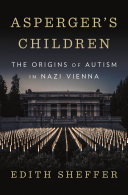
Asperger's Children
The Origins of Autism in Nazi Vienna
منشا اوتیسم در وین نازی
کتاب های مرتبط
- اطلاعات
- نقد و بررسی
- دیدگاه کاربران
نقد و بررسی

March 15, 2018
The reputation of child psychiatrist Hans Asperger (1906-1980) comes under close scrutiny in this chilling and well-documented account of how the political and social values of Nazi psychiatry determined the fates of supposedly inferior children.Sheffer (Modern European History/Stanford Univ.; Burned Bridge: How East and West Germany Made the Iron Curtain, 2011) reveals how the Nazi regime categorized children and examines Asperger's role in its killing system. In its first conference in 1940 in Vienna, the German Society for Child Psychiatry and Curative Education established the doctrine of eugenicist selection and "the grandiose experiment of Nazi child psychiatry as a distinct field." Experts would differentiate between children who were valuable to society and who, in the words of Paul Schröder, "the Reich's 'father' of child psychiatry," were "mostly worthless and ineducable." Asperger, present at the convention, endorsed this doctrine and became director of the Curative Education Clinic at the University of Vienna Hospital, where, as a medical consultant for the Nazi administration, he assessed children. On numerous occasions--likely hundreds of times--he recommended transfer to Spiegelgrund, the clinic in Vienna where "inferior" children were killed under the state's euthanasia program. Sheffer's research demonstrates how Asperger's diagnoses emerged from the values of the Nazi regime, and her account is filled with revealing notes from Asperger's clinic and disturbing stories of the experiences of children who survived Spiegelgrund. The author examines Asperger's writings and his career after the war, when he claimed that he was a resister of Nazism. She reports that he has been viewed in various ways: as "a resister who rescued children, as a determined perpetrator, or as a passive follower." Her own conclusion--that he was a conscious participant--is persuasive.A compelling picture of the evils of the Nazi regime and of the perversion of Nazi psychiatry.
COPYRIGHT(2018) Kirkus Reviews, ALL RIGHTS RESERVED.

Starred review from March 26, 2018
Historian Sheffer (Burned Bridge: How East and West Germans Made the Iron Curtain) examines the confounding legacy of Austrian psychiatrist Hans Asperger, who worked with autistic children during the 1930s and ’40s, unveiling a figure who initially offered benevolent support to some autistic children, but then death to others. In 1937, Asperger advocated a nonjudgmental approach toward children’s differences; a year later, following the Nazi annexation of Austria, he publicly recommended “the overhaul of medicine according to guiding principles of National Socialism”—with its emphases on group assimilation and physical perfection as determinants of whether people deserved to live or die—and introduced his concept of “autistic psychopathy,” which forms the basis of the present-day diagnosis of autism spectrum disorder. Asperger was likely involved in sending 44 children to the Vienna Municipal Youth Welfare Institution at Spiegelgrund, where at least 789 children died, inhumane neglect and brutal punishments were daily rituals, and euthanasia was considered a treatment. “Evil just a part of life” there, one survivor later wrote; “it was everyday life, and nobody questioned it.” At the end of the war, Asperger was cleared of wrongdoing and even described his war service as somewhat heroic; he continued an illustrious career in child psychiatry. This is a revelatory, haunting biography of a gifted practitioner who chose to fall in line with the Nazi regime and the far-reaching consequences of that choice, for his own patients and for those still using and being labeled with the diagnostic concepts he originated.

April 15, 2018
Historian, author, and parent of a child diagnosed with autism, Sheffer (senior fellow, Inst. of European Studies, Univ. of California, Berkeley; Burned Bridge) delves into the story of Hans Asperger (after whom Asperger's syndrome is named). Asperger was the director of the Curative Education Clinic at the University of Vienna Children's Hospital in Vienna during the years leading up to World War II. A practicing Catholic and believed not to have joined the Nazis, Asperger has been favorably regarded. Sheffer makes clear that her subject was a minor figure in the child euthanasia program (unlike his contemporaries such as Heinrich Gross). However, Asperger not only worked but thrived within a system of mass killings, wherein increasing categorization of defects led to state-imposed murder. He labeled children as being of positive or negative worth, with the "unworthy" placed in Vienna's infamous Spiegelgrund institution. Sheffer's descriptions of the children and excerpts from their letters are heartbreaking. VERDICT A tragic yet thought-provoking and extensively researched account that vividly portrays the child victims. This remains a cautionary tale of the influences on diagnoses and how dangerous they can be.--Elizabeth Safford, Boxford Town Lib., MA
Copyright 2018 Library Journal, LLC Used with permission.

























دیدگاه کاربران